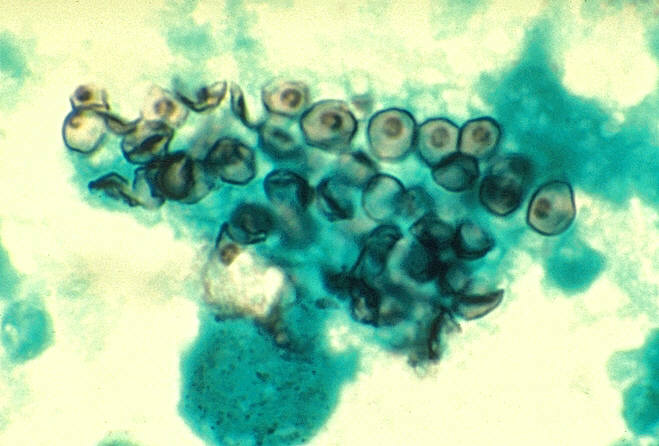
Adverse reactions to TMP-SMX are much more likely in HIV+ patients, thought to be because of systemic glutathione deficiency that renders HIV+ patients less able to deal with TMP-SMX metabolites.
TMP-SMX works by inhibiting bacterial synthesis of tetrahydrofolic acid - bacteria are obligate folic acid synthesizers, but we get it from our diet. The trimethoprim and sulfamethoxazole components do this through different mechanism.
Side effects include:
GI:
Nausea, vomiting, anorexia can occur, with glossitis, stomatitis, and diarrhea occurring less frequently. Hepatotoxicity is rare.
Derm:
Maculopapular rashes, urticaria, erythema, morbilliform lesions, erythema multiforme, purpura, and photosensitivity can all occur. Stevens Johnson syndrome and toxic epidermal necrolysis can occur, from the sulfa component.
Renal:
Elevated Cr (but retained GFR),hyperkalemia (careful with ACE/ARB!)
Heme:
Megaloblastic anemia in patients with low folate stores. Rarely agranulocytosis, granulocytopenia, anemia, thrombocytopenia
In HIV patients it is useful to think of reactions as either Hypersensitivity or Other. Hypersensitivity reactions typically occur 8-12 days after initiation, and include diffuse rash, rising LFTs, azotemia, nausea, vomiting, and diarrhea. SJS/TEN can occur.
Absolute contraindications to continuing or ever restarting TMP-SMX include SJS/TEN, severe hypersensitivity reaction, anaphylaxis, or severe cytopenias. In the absence of these concerns, it may be reasonable to try to treat adverse reactions symptomatically while continuing TMP-SMX or attempting dose escalation sensitization.
Treatment of PJP pneumonia is ideally with TMP-SMX 5mg/kg q8h, which has been shown to be superior to pentamidine. Alternatives to TMP-SMX include dapsone 100mg/d PO + trimethoprim 5mg/kg q8h PO x 21 days, or clinda + primaquine, or atovaquone, or pentamidine IV.
Here's a free freetext link to a useful review of TMP-SMX.
Here's a useful review of dermatologic manifestations of HIV.
Remember that in a patient with a CD4 count this low, a rash may be due to a number of causes, including:
HIV itself with it's myriad derm manifestations
Other Infection (gonococcal, varicella, syphilis)
Malignancy (lymphoma, Kaposi's Sarcoma)
Drug-reaction to ARVs (nevirapine, abacavir)
Drug-reaction to other Rx (TMP-SMX).
Hope you find that useful!
Absolutely beautiful!
ReplyDeleteFirst and foremost, I would like to thank Malika for creating the blog and for her time and consideration in e-mailing out the pertinent issues discussed in morning report and supplying us with articles for further reading! I, along with many, appreciate it immensely! :-)
I apologize in advance for having missed morning report this morning, but our team was post-call!
I thought I would go on a slight tangent and continue talking about drug-induced dermatological findings in HIV+ patients focusing on abacavir hypersensitivity reaction and HLA-B*5701 testing. The abacavir hypersensitivity reaction can occur in approximately 5-8% of all HLA-B*5701+ patients commencing abacavir, and this is a delayed reaction occuring approximately 6 weeks post-initiation of treatment with abacavir. Please do note that depending on the CD4+ count, if low, the immune reconstitution inflammatory syndrome is always a possibility as well and all other opportunistic infections can occur upon starting HAART. Prior to placing any patient on abacavir, HLA-B*5701 testing is performed. The test has a PPV of approximately 74%, but the NPV is approximately 97%; therefore, if a patient were to present with a more mildly diffuse rash than that presented today in morning report, and please do note that this may be in the setting of other presenting symptoms including fever, GI issues, respiratory issues, and consitutional symptoms, abacavir hypersensitivity reaction may be the diagnosis. The reason for my posting this is that if one were to rechallenge a patient with this abacavir hypersensitivity reaction, it may have potentially life-threatening consequences - death. There is patch test screening, but I am not too sure about how readily available this is in a clinical setting. If anyone has any ideas or further insight, please do enlighten me.
I hope that you find this as fascinating as I!
Gianni Lorello